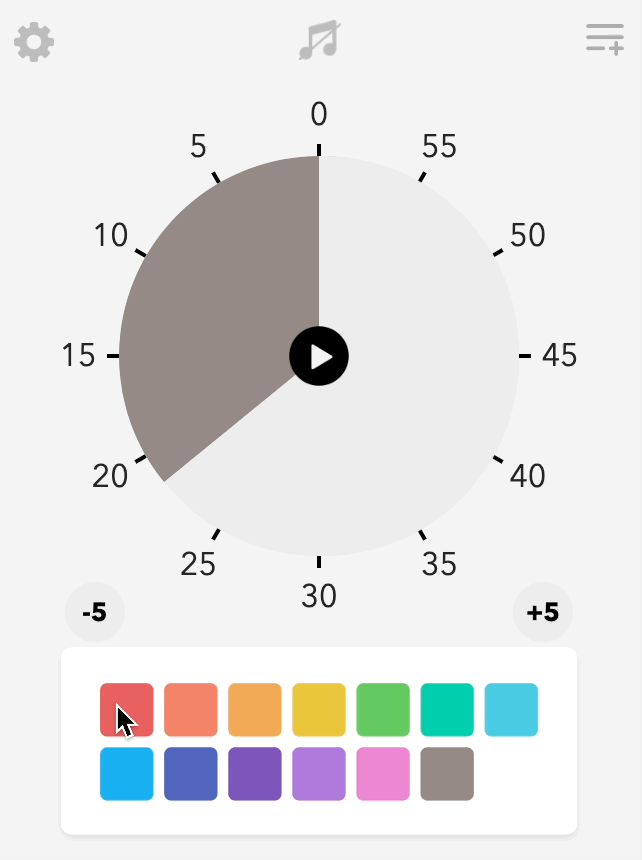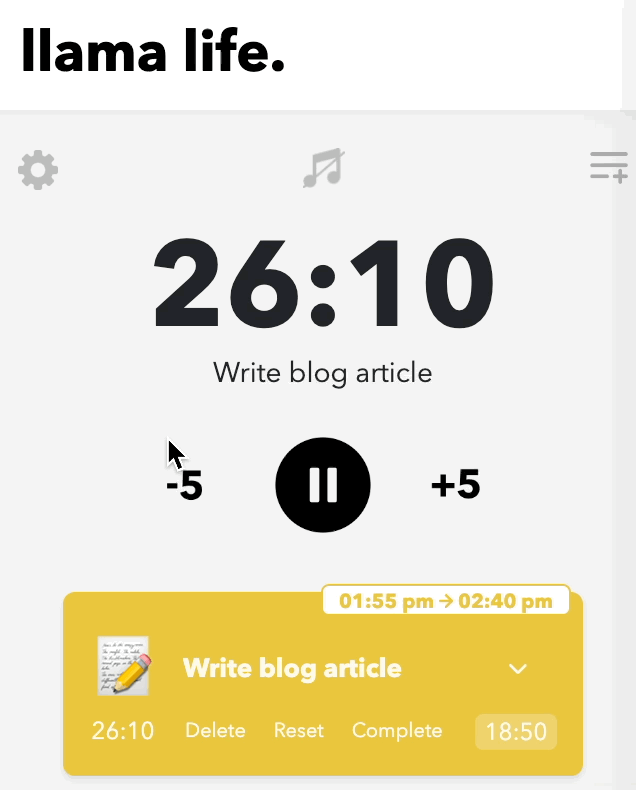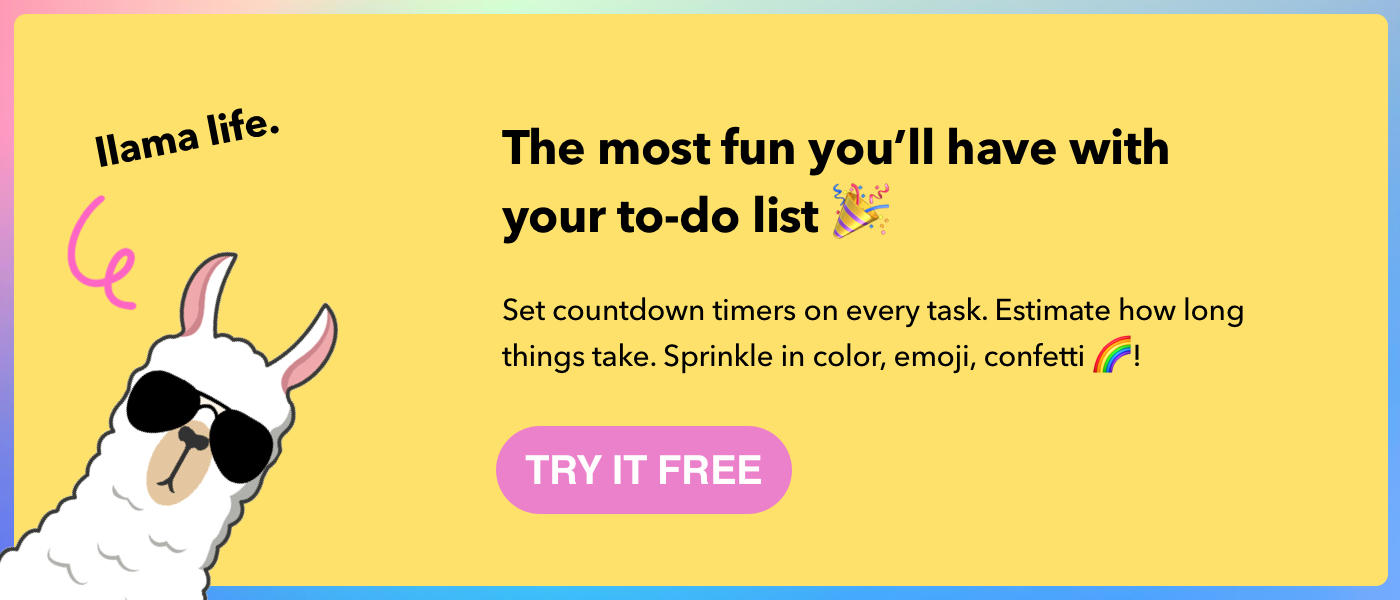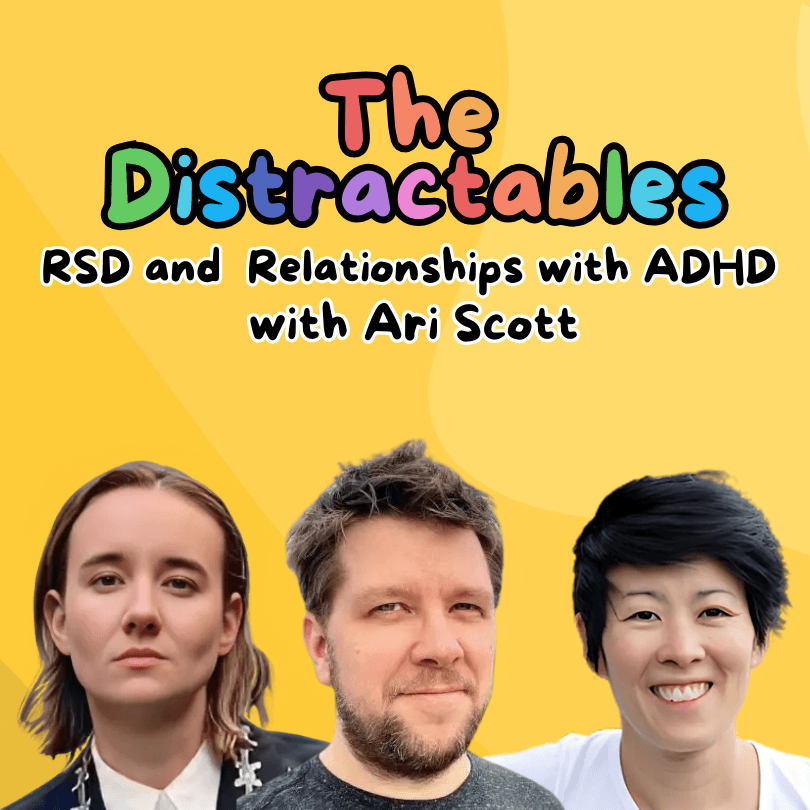Time is constantly ticking away, whether we like it or not. But for those of us with Attention Deficit Hyperactivity Disorder (ADHD), the concept of time can be very tricky to grasp.
If you're reading this (hello!), chances are you're all too familiar with the struggle of time management.
Maybe you've lost track of time and missed an important meeting, or you've found yourself stuck in a hyperfocused state for hours on end, throwing everything else out of the picture. Or you often struggle to estimate how long anything will take to do.
Don't worry, you're definitely not alone!
A lot of us have been there, and it's all thanks to a little thing called time blindness – a pesky symptom of ADHD that makes it difficult for us ADHDers to grasp the concept of time.
But fear not, my friends!
I have a solution that can help you conquer this common ADHD challenge: the ADHD Timer.
Time blindness can be a real challenge
But first, let's chat about time blindness.
We can often lose track of time and end up not getting everything done that we need to, which can be frustrating for the people around us who rely on us.
For example, have you ever promised to meet a friend for lunch at 12 pm, only to show up at 1 pm, feeling guilty and frantic, as you were completely oblivious to how much time had passed?
I know I have, and it's not a good feeling (especially when it’s repeated).
Another way time blindness can manifest is through over-commitment.
We tend to think we can do more than is realistic in a given timeframe, which leads us to be stressed, overworked, and again, risking our relationships with others.
For instance, we might agree to take on an extra project at work, thinking we can handle it alongside our current workload, only to find ourselves overwhelmed and unable to keep up with our responsibilities.
And let's not forget about our pal – procrastination.
What we thought was going to be a quick five minute scroll through Instagram turns into an hour or more of wasted time that is, in hindsight, filled with a big bowl full of guilt.
This is especially dangerous for us ADHDers because we can easily get sucked into distractions and lose sight of our goals and priorities.
All of these experiences are a result of time blindness, and as we can see, time blindness can affect our lives and well-being in significant ways.
This is where the ADHD Timer comes in, especially of the visual variety!
3 benefits of visual timers for ADHD adults
There are three main benefits of using visual timers for ADHD:
1. Track how long you've spent on a task
As someone with ADHD or time blindness, it's easy to lose track of time and get caught up in a task for longer than we intended. ADHD timers allow you to timebox a task (limit a task to a certain amount of time) and remind you when that time is up and you should move on to the next task.
In one study, it as found that using a visual timer (like the Time Timer) helped students with autism spectrum disorders (ASD) transition smoothly from computer time to work time. This is because having a visual timer allowed the students to 'see' how much time was left.
2. Help keep you focused on the task
Most ADHD timers are visual timers which provide a visual reminder of the passing of time which can serve as a powerful motivator to stay focused. Most timers also have sounds such as loud ticking or alarm features that provide an auditory reminder that the timer is going and you should be focused on the task.
Llama Life for instance, has an optional chimes feature that you can customize to go off at regular intervals while your timer is going. When you have clear reminders, both visual and auditory, of what you should be spending your time on, it's easier to stay focused and avoid distractions.
3. Help improve your concept of time and reduce time blindness
This is the best part! By forcing us to put a little more thought into how much time a task will take, and tracking our progress, we can get a more realistic understanding of how long things actually take in the long term. And by practicing this, we can improve our ability to estimate times for both boring tasks, and challenging tasks!
And let's be honest, we ADHDers could use a little help in all of these departments. Not bad for just a timer right? 🙌🏻
So if you're looking for a simple and effective solution to improving your time management woes, give a visual timer a try.
With that said, let's uncover some of the best ADHD timer options currently available in the market
4 proven ADHD timers to help you stay focused
As someone who has ADHD, I can tell you firsthand that managing time is not child's play.
It's like trying to herd cats, am I right?
That's why I firmly believe that every ADHDer could benefit from having an ADHD timer for optimal time management.
And not just any ADHD timer, but the best ones that are loved by their users and proven to help you stay focused:
- Llama Life: Llama Life is the ultimate ADHD tool for adults that enables productive single tasking via a simple and beautifully designed web-app. The app helps you focus on the task at hand with the help of many features and capabilities including – visual Pomodoro timer, time boxing, soundscapes (white/brown noise) for focus, countdown pie timer, emoji and dopamine inducing confetti and many more. Llama Life is also highly customizable to how your brain works.
- Time Timer Plus: This little gadget is a game-changer for anyone with ADHD. The Time Timer Plus is a physical timer that displays the time remaining in a countdown pie format (60 minutes), making it easy to see how much time you have left to complete a task.
- Forest: Forest app takes a unique approach to time management by turning it into a game. With Forest, you plant a virtual tree, and it grows as you work. If you leave the app to check social media or do something else, your tree dies. This is a profound way to motivate you to stay focused and get your work done so that you can grow a beautiful virtual forest.
- Pomodoro Method: Not an ADHD timer as such, but the Pomodoro Technique is a time-management method that has been proven to increase productivity and focus for many. It involves working for a standard rate of 25 minutes and then taking a 5 minute break. Websites like Pomofocus and Llama Life allow a simple way to set up these timers.
These are just a few examples of the best ADHD timers out there.
Of course, there are many others to choose from, so it's important to find the one that works best for you. But no matter which ADHD timer you pick, the critical thing is to try to stick to it consistently.
Now that you have discovered some useful ADHD timers, both physical and digital, it's time to address the biggest difference between the two, and which would work best for you.
Physical timers vs. timer apps for ADHD
Physical timers are classic and timeless, and come in all sorts of shapes and sizes. From the classic egg timer to the more modern digital stopwatch, physical timers offer a tangible way to keep track of time.
They can be accommodating for those of us who are more visually inclined and need something concrete and always visible to help us stay on track.
On the downside, physical timers can be bulky, and if you forget to bring them with you, you're out of luck. They can also be distracting if you're someone who is easily stimulated by visual or auditory stimuli.
Next up, we have timer apps. Timer apps are convenient and versatile. They're always with you on your device, so you can use them wherever you go.
Another huge benefits of timer apps is that they record your task and timer data so that you can have a history of each task and how long it took. With a physical timer, there is no data or history beyond the task you're currently timing.
Timer apps are also often customizable, so you can set them to your liking, whether that means different sounds, different colors, or different settings.
On the downside, timer apps can be a little overwhelming. With so many options and settings, it can be hard to decide what works best for you. Plus, they rely on your device, which can also be a source of distraction.
A few more differentiators to consider to help you decide:
Features | Physical Timers | Digital Timer Apps |
Portability | Potentially bulky and may not be easy to carry around | Portable and easily accessible on phones and tablets |
Customization | Often limited customization options | Generally highly customizable with various settings and options |
Distractions | Minimal distractions, as they typically have only one function | More potential distractions, as they are often used on a multi-functional device |
Visual Feedback | Provides a clear visual representation of time remaining | Can also provide a clear visual representation of time remaining |
Cost | Generally inexpensive (one-time purchase) | May require purchasing an app or subscription, but may also have free trial options available |
Data | No record of past tasks or how long they took | Often provide a record of tasks you've worked on and how long they've taken |
So, which one should you go with? 🤔
If you're someone who likes to see and touch things, a physical timer might be the way to go. If you're someone who is always on the go and needs something more portable, a timer app might be the better option.
At the end of the day, what matters most is finding a timer that works for you and helps you manage your time better.
Whether it's a physical timer or a timer app, the important thing is that you're using it and taking control of your time. It may also be a combination of the two that works well for you!
The 'TikTok ADHD Visual Timer' – Does it live up to the hype?
For those of you who are new to the ADHD TikTok and Twitter subtopic, it's a place where people often come together to share experiences, tips, and resources to help navigate life with ADHD.
And lately, many ADHD content creators and influencers have been raving about visual timers.
And rightly so.
Firstly, let me explain what the TikTok ADHD Visual Timer is. It's a physical timer that you can set for any amount of time you need. It's one which is simple to use. And a timer that someone with ADHD might find useful in tracking time and improving their time management skills.
There are a range of visual timers that have been recommended by ADHD advocates, writers and content creators. Some that often pop up are the Time Timer, sand timers, and the good old kitchen egg timer.
But of course, everyone's experience with ADHD is different, so what worked for someone else may not work for you. If you're not a fan of physical timers, don't worry – there are plenty of digital options out there as well.
Make sure you add break time in between tasks!
A quick tip for using an ADHD timer: it's not just about staying focused. It's also about taking breaks.
That's right, my friends, breaks are important!
And I'm not just talking about scrolling through social media for five minutes. I'm talking about real, intentional breaks.
Why are breaks so indispensable, you ask?
Well, for starters, they give our brains a chance to rest and recharge. When we're constantly pushing ourselves to focus, focus, focus, our brains can get burnt out. Taking breaks helps us avoid that burnout and stay fresh and alert.
But it's not just about avoiding burnout.
Taking breaks can actually improve our productivity. When we take breaks, we give ourselves a chance to step back and see the bigger picture. We give ourselves time to ruminate on problems.
We can evaluate what we've accomplished so far and figure out what we need to do next. Plus, taking breaks can help us come up with new ideas and solutions to problems we've been struggling with.
Maybe you could try some yoga, take a walk, or even just dance around your room for a few minutes.
It's up to you what works well for a break - the possibilities are endless!
7 things to look for in an ADHD timer
Ok, so you're now ready to try out an ADHD timer! Here are some things to look for when choosing an ADHD timer that will work for you:
1. Friendly and fun design
The timer interface should be designed in a way that is easy on the eyes and soothing to the mind. Some timers can be overwhelming, with loud noises or robotic designs that can cause anxiety and make work feel like a chore.
Look for a timer that is fun to use, won't cause anxiety, and inspires you to get started. And it must be easy to use! Llama Life is a great example of an ADHD timer with a user-friendly interface that features calming colors, emojis, and a fun countdown timer.
2. Help with feeling overwhelmed and distractions
It can feel overwhelming when we have a long list of tasks to complete, and often, we'r open to more distractions when feeling overwhelmed. Choose a tool that acknowledges this and has built in calming sounds to help you relax and focus - as well as drown out distractions.
3. Option for a countdown timer as well as a timer that counts up
The type of timer you choose will depend on your specific needs and your personal preferences. Choose a tool that offers different options for further flexibility.
Llama Life offers a digital countdown timer as well as a pie timer. Some may prefer the pie timer as they can literally see time disappearing, whilst others may prefer the digital timer.
Another timer that Llama Life offers, is one which counts up and captures any additional time worked on a task. This Overtime feature is perfect for when you're in flow, or are taking longer than originally planned.
4. Different alarm options
An ADHD timer is only useful if you know when the timer is done. Look for a timer that has an alarm option to suit your needs and preferences. It's important to choose an alarm sound that will get your attention without causing anxiety.
Llama Life offers three different alarms to choose from:
- Silent/Visual - no sound, flashes color when time is up.
- Nag Alarm - plays sound when time is up, then reminds you every minute until you turn it off.
- Continuous - plays sounds when time is up, then plays continuously until you turn it off.
5. Easy way to add extra time
Let's face it, sometimes we need more time to complete a task. Look for a timer that has an easy way to add extra time.
6. Customizable and flexible settings
Everyone's needs and preferences are different, so it's important to choose a timer that allows for customization, as well as flexibility to how you use it. Look for a timer that lets you easily adjust the time intervals, sound preferences, and other settings to suit your specific needs.
7. Data tracking and analysis
Some timers come with features that allow you to track your progress and analyze your productivity over time. This can be a useful tool for identifying patterns in your work habits, and can help you make adjustments to improve your efficiency and effectiveness. Llama Life provides a simple report which you can review on a daily basis or as often as you like.
Overall, the most important things to look for in an ADHD timer is a tool that helps you stay focused, motivated, and productive.
Whether you prefer a countdown or count up timer, a soothing or stimulating sound, or a simple or customizable interface, there is an ADHD timer out there that can help you achieve your goals.
Other time management tools recommended for ADHD
Now that we've explored ADHD timers in detail, it's worth mentioning a few other time management tools often recommended for ADHDers.
- Calendars: Calendars are a great way to keep track of your schedule and stay on top of your appointments and deadlines. If you're planning with other people, don't be afraid to ask them to send you a calendar invite. Most people are more than happy to do this, and it can be a lifesaver for those of us with ADHD. You can also create calendar events for yourself, whether it's a reminder to take your medication or a block of time to work on a specific task
- Accountability Buddies: Find a friend or family member (or a provider like Shelpful) who understands your struggles with ADHD and ask them to help keep you accountable. You can meet with them regularly and tell them how long you plan to work on a task. At Llama Life, we take accountability to the next level with our "get shit done" sessions. We meet up for an hour over Zoom and focus on the annoying tasks we've been avoiding but need to get done. It's amazing how much you can accomplish in just an hour when you have someone else there to hold you accountable.
- Watches: Watches, specifically, the Apple Watch. If you have one, you know how useful it can be for keeping track of your schedule and staying on task. With the ability to connect to your calendar, you'll never miss an appointment or deadline again.
So there you have it, some other time management tools to add to your tool belt!
Lastly, everyone's journey with ADHD is unique, so it's important to find what works best for you.
Remember, don't be afraid to experiment with different tools and techniques until you find the ones that help you thrive.
Written by: Dhruvir Zalar
I aim to write blog posts that help ADHD warriors by simplifying complex topics and distilling them in the form of actionable and data-driven articles. When I'm not writing or editing, you can find me reading books (mostly non-fiction) or playing table tennis (badly).













